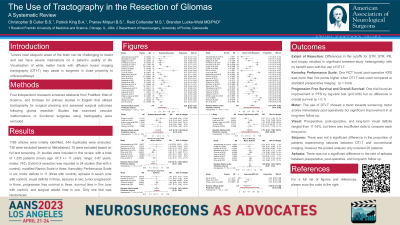The Use of Tractography in the Resection of Gliomas: a Systematic Review
The Use of Tractography in the Resection of Gliomas: A Systematic Review
Friday, April 21, 2023


Patrick J. King (he/him/his)
Medical Student
Chicago Medical School
Chicago, Illinois, United States
ePoster Presenter(s)
Introduction: Tumors located in eloquent areas of the brain provide a challenge for neurosurgeons and can have severe implications on a patient’s quality of life. Diffusion tensor imaging (DTI) tractography allows for visualization of white matter tracts, allowing for tumor resection in close proximity to critical pathways. Preservation of these tracts allows for improved outcomes and survivability. This systematic review aims to investigate outcomes of glioma resection aided with tractography.
Methods: Four independent reviewers screened abstracts from Pubmed, Web of Science and Embase for primary studies in English that utilized tractography for surgical planning and assessed surgical outcomes following glioma resection. Vascular malformation and functional surgeries using tractography were excluded.
Results: Thirty-one studies were included in this review with a total of 1,235 patients (mean age: 47.7 years, range: 3-87 years, standard deviation: 11.4 years, males: 742). Twenty-eight of the included studies were retrospective or prospective case series. Seventeen studies used neuronavigation, 13 used intraoperative neuromonitoring, and 10 used both modalities in addition to tractography. Gross total resection was achieved in 596 patients (48%) but was not reported in 7 studies. Six studies reported post-op KPS scores (median: 80). Other reported outcomes included morbidity, mortality, tumor recurrence, progression-free survival, and overall survival.
Conclusion : Through the visualization of subcortical tracts, tractography is not only becoming a promising adjunct in surgical planning, but also becoming a powerful predictor of clinical deficits and rehabilitation potential. The results from this paper demonstrate that tractography has an increasingly large role in surgical planning as neurosurgical practice shifts more towards individual, patient-tailored surgical interventions, especially for higher-grade glioma resections. Large variations in the included studies with regards to outcome variables and design will necessitate further research into the optimal use cases of in-vivo tractography.
Methods: Four independent reviewers screened abstracts from Pubmed, Web of Science and Embase for primary studies in English that utilized tractography for surgical planning and assessed surgical outcomes following glioma resection. Vascular malformation and functional surgeries using tractography were excluded.
Results: Thirty-one studies were included in this review with a total of 1,235 patients (mean age: 47.7 years, range: 3-87 years, standard deviation: 11.4 years, males: 742). Twenty-eight of the included studies were retrospective or prospective case series. Seventeen studies used neuronavigation, 13 used intraoperative neuromonitoring, and 10 used both modalities in addition to tractography. Gross total resection was achieved in 596 patients (48%) but was not reported in 7 studies. Six studies reported post-op KPS scores (median: 80). Other reported outcomes included morbidity, mortality, tumor recurrence, progression-free survival, and overall survival.
Conclusion : Through the visualization of subcortical tracts, tractography is not only becoming a promising adjunct in surgical planning, but also becoming a powerful predictor of clinical deficits and rehabilitation potential. The results from this paper demonstrate that tractography has an increasingly large role in surgical planning as neurosurgical practice shifts more towards individual, patient-tailored surgical interventions, especially for higher-grade glioma resections. Large variations in the included studies with regards to outcome variables and design will necessitate further research into the optimal use cases of in-vivo tractography.
